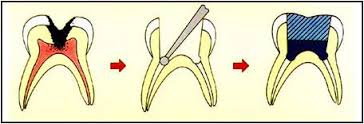Baby Root Canal

Young children can lose their baby teeth (primary teeth) and even immature permanent teeth when the living tissue called the pulp becomes infected. This is often the result of trauma or cavities. It can cause a special problem for your child. Contrary to popular beliefs, your child’s baby teeth are just as important as their permanent, adult teeth. They provide important guides for the newly developing permanent teeth that will replace them. In order to treat a baby tooth that has an infected pulp, the pediatric dentist will perform a Therapeutic Pulpotomy, also known as a Baby Root Canal.
A Baby Root Canal is performed on the primary teeth when the pulp becomes infected due to trauma or cavities. Because the baby teeth have a good supply of blood, a Baby Root Canal can be successful in saving the baby tooth. There are a few different types of baby root canal therapies that the pediatric dentist may perform on your child.
Indirect pulp treatment works best for teeth with deep decay approaching and/or barely exposing the pulp, where removing all the decayed parts of the tooth would expose it. Instead, the pediatric dentist will remove as much “soft decay” as possible. This will leave only the harder remnants without penetrating into the pulp. Then applying an antibacterial agent and restoring the tooth to seal it prevents further infection. A temporary filling is then placed in the tooth to ensure comfort and healing. A more permanent filling is placed after 10-12 weeks. Speak to your pediatric dentist for more information.
Pulpotomy is literally a “partial pulp removal,” a tried and tested technique, and is successful in 90% of cases. It is used to treat pulp exposures, a result of decay in primary teeth. The procedure includes removal of the pulp and preserving the vitality of the remaining root areas of the pulp. Success is based on the pediatric dentist’s determination of whether the remaining pulp is healthy. Effective control of infection is also very important. It includes complete removal of inflamed pulp tissue, appropriate wound dressing, and effective sealing of the tooth during and after treatment. Pediatric Dentists use medicines and preparations to stabilize vital tissue and prevent it from becoming infected. This allows the remaining vital or living tissues of the pulp to survive so that the tooth can function normally until lost naturally.
Another type of baby root canal is called a Pulpectomy. This procedure involves complete removal of all the pulp tissue because it is infected. If a child has tooth pain, particularly if there has been accompanying swelling of the gum tissues or cheek, this will need to be managed first. A small opening is drilled in the biting surface of the tooth to drain infection and/or a course of antibiotics is given. This will set the stage for the removal of infected tissue from the root canal/s completely. This procedure resembles traditional root canal treatment, with removal of all the infected tissue from the root canals; disinfecting, cleaning, shaping and filling the canals to seal them. Upon completion of root canal treatment for primary teeth, the restoration of choice for a back tooth is a stainless steel crown and, for a front tooth, a composite tooth-colored resin.





